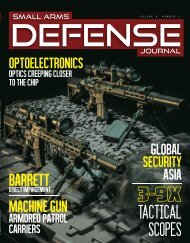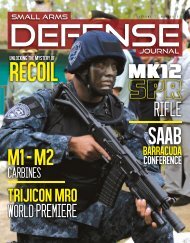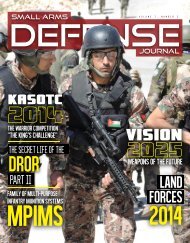SAR 18#6
You also want an ePaper? Increase the reach of your titles
YUMPU automatically turns print PDFs into web optimized ePapers that Google loves.
against actual simulated-combat data<br />
from competing conventional weapons,<br />
showed the SPIW as being clearly superior<br />
to the best existing weapons in<br />
the world. The heavily slanted nature of<br />
these comparative standings led to the<br />
fatal temptation to confuse potentiality<br />
with reality.<br />
Ed Ezell to the Rescue<br />
While attending the U.S. Army Show<br />
in Washington in 1984, I remember mentioning<br />
my fascination with the SPIW to<br />
Dan Musgrave, a very knowledgeable<br />
and respected author with a prestigious<br />
military career behind him. Dan shook<br />
his head and remarked, “You will never<br />
find out anything about the SPIW. It was<br />
so embarrassing it has all been buried<br />
so deeply it will never be found.” However,<br />
thanks to the efforts of the late Edward<br />
C. Ezell, Ph.D., then the Curator of<br />
Military History at the Smithsonian’s Museum<br />
of American History, the story was<br />
indeed unearthed in voluminous detail,<br />
and became the subject of the Collector<br />
Grade title The SPIW - The Deadliest<br />
Weapon that Never Was, which was<br />
co-authored by myself and Dr. Ezell and<br />
published in 1985. The following copyrighted<br />
material is largely excerpted<br />
directly from this long-out-of-print book.<br />
Origins of the SPIW Program<br />
As described in Chapter One of The<br />
SPIW, the origins of the program go<br />
back to the early postwar period, during<br />
the dawn of the computer age.<br />
The Hall Study<br />
The Ballistic Research Laboratories<br />
(BRL) had been formed at Aberdeen<br />
Proving Ground in 1938, with an ongoing<br />
mandate to conduct basic ballistic<br />
research for the Army. The official reason<br />
behind the ground-breaking BRL<br />
study into combat rifle effectiveness<br />
was to address the unsettling fact that,<br />
despite the Army’s doctrinal insistence<br />
on accurate, long-range aimed rifle fire,<br />
an estimated 50,000 rounds of ammunition<br />
had been expended per enemy casualty<br />
during World War II. The results<br />
of the study by Mr. Donald L. Hall were<br />
released in BRL Memorandum Report<br />
No. 593, dated March 1952, entitled An<br />
Effectiveness Study of the Infantry Rifle.<br />
The Hall Study was the first real,<br />
authenticating publicity for the fledgling<br />
small caliber, high velocity (SCHV) concept,<br />
a new and cooperative research<br />
effort involving Aberdeen’s Development<br />
and Proof Services (D&PS) and<br />
the Ballistic Research Laboratory (BRL).<br />
Mr. Hall blended the initial SCHV results<br />
with his own theoretical studies to produce<br />
history’s first serious espousal of<br />
the small caliber concept:<br />
The theoretical consideration of a<br />
family of rifles indicates that smaller<br />
caliber rifles than the .30 have a greater<br />
single-shot kill probability than the cal.<br />
.30 M1. This is obtained by increasing<br />
the muzzle velocity and thereby obtaining<br />
a flatter trajectory, so that the adverse<br />
effect of range estimation errors<br />
is reduced.<br />
When the combined weight of gun<br />
and ammunition is held constant at fifteen<br />
pounds, the overall expected number<br />
of kills for the cal. .21 rifle is approximately<br />
21/2 times that of the present<br />
standard cal. .30 rifle. If the number of<br />
rounds is fixed at 96, the total load carried<br />
by a soldier with a cal. .21 rifle and<br />
ammunition with 6/10 the charge in the<br />
M2 cartridge will be 3.6 lbs. less than<br />
that carried by a soldier with a cal. .30<br />
rifle. This is a 25% reduction in load.<br />
Furthermore, if it were necessary for<br />
a soldier with the M1 to carry the rounds<br />
required for the same expected number<br />
of kills at 500 yards as a soldier with 15<br />
lbs. of cal. .21 6/10 charge rifle and ammunition,<br />
it would be necessary for him<br />
to carry 10 lbs. more ammunition, or a<br />
total load of 25 lbs.<br />
The Hitchman Report<br />
In September, 1948 the Army General<br />
Staff created the civilian Operations<br />
Research Office (ORO), whose initial<br />
mandate was to supply the Army with<br />
scientific advice about the conduct of<br />
nuclear war.<br />
The second important study under<br />
discussion here complemented but<br />
greatly expanded on the Hall Study. It<br />
was presented by the head of ORO’s<br />
Infantry Division, Norman A. Hitchman,<br />
on June 19, 1952. Originally<br />
classified SECRET, ORO’s Technical<br />
Memorandum ORO-T-160 was entitled<br />
Operational Requirements for an<br />
Infantry Hand Weapon.<br />
The Hitchman Report began where<br />
the Hall Study had left off, taking as its<br />
gospel that “it is desirable to increase<br />
in both number and rate the hits which<br />
may be inflicted on the enemy by aimed<br />
small arms in the hands of the infantry.”<br />
ORO summed up these opening<br />
remarks by stressing that the “severity<br />
of weapons as measured by their<br />
lethality has not changed, at least in<br />
the past century.”<br />
There was stubborn Army opposition,<br />
especially among Ordnance officials,<br />
to this ORO attempt to quantify<br />
certain parameters as they truly existed,<br />
as opposed to how they had traditionally<br />
been perceived, regarding the infantry<br />
rifle and its effectiveness in combat.<br />
Out of all the combined British and<br />
American research available, 80% of<br />
the effective rifle and LMG fire had been<br />
reported at ranges under 200 yards,<br />
with a full 90% under 300 yards. This<br />
substantiated the Hall Study, wherein<br />
hit probability from small arms fire<br />
at ranges exceeding 300 yards rapidly<br />
descended into the “negligible.”<br />
<strong>SAR</strong> Vol. 18, No. 6 92 Nov., Dec. 2014









